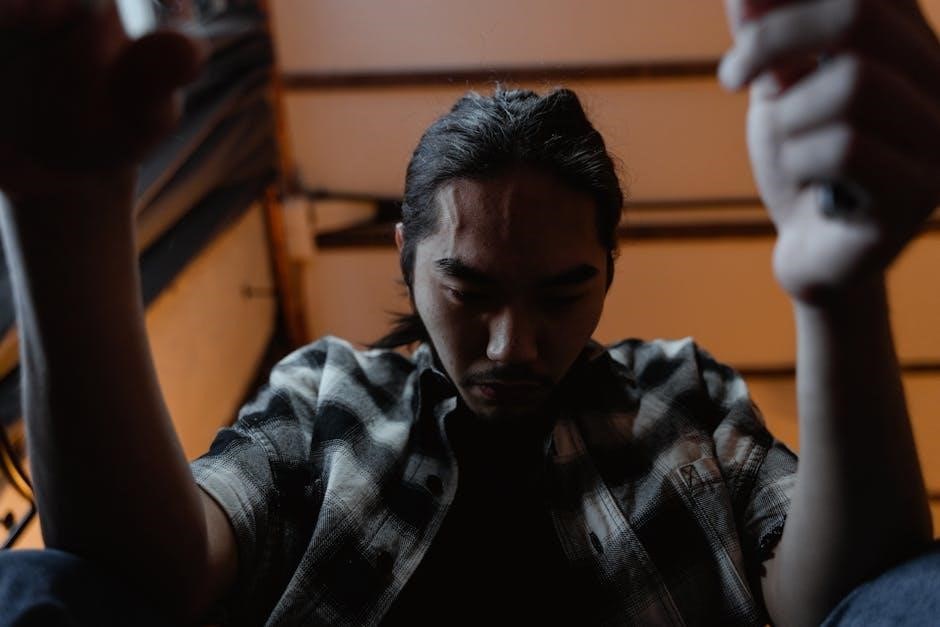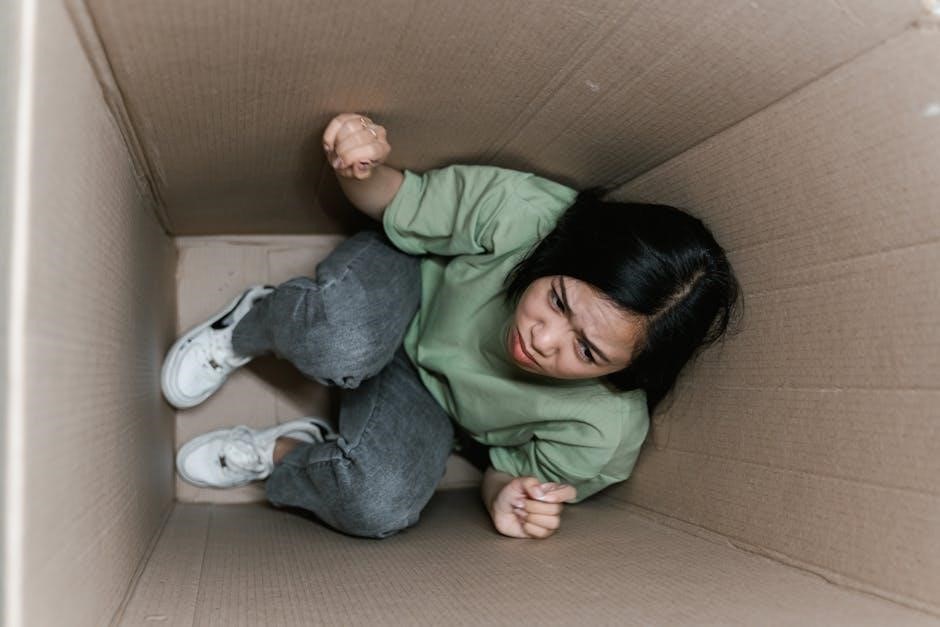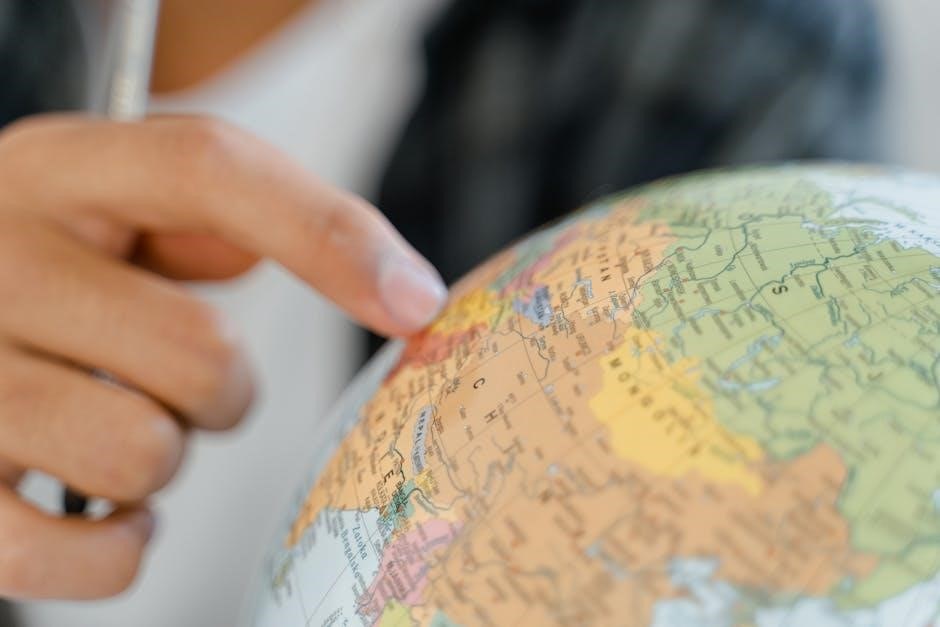Internalized homophobia is a complex issue stemming from societal biases, leading to self-loathing and emotional distress among LGBTQ+ individuals, often resulting in shame and self-hatred.
Definition and Overview
Internalized homophobia refers to the process by which LGBTQ+ individuals unconsciously adopt and internalize societal prejudices and biases against their own sexual orientation. This phenomenon occurs when individuals absorb homophobic messages from their environment, leading to feelings of self-loathing, shame, and denial. It often manifests as a rejection of one’s true identity, attempts to change sexual orientation, or a deep-seated belief that being queer is inferior or wrong. This internal conflict can stem from cultural, religious, or social norms that perpetuate heterosexism and homophobia. Understanding internalized homophobia is crucial for addressing its harmful effects on mental health and well-being, as it often lies at the root of emotional distress and self-hatred within the LGBTQ+ community.
The Impact of Societal Biases on LGBTQ+ Individuals
Societal biases play a significant role in shaping the experiences of LGBTQ+ individuals, often perpetuating internalized homophobia. These biases, rooted in heterosexism and homophobia, are reinforced through cultural norms, religious teachings, and media representation. Discrimination, rejection, and marginalization can lead to feelings of inferiority and self-doubt. The constant exposure to negative messages about queerness forces many individuals to internalize these beliefs, resulting in self-loathing and emotional distress. This societal influence not only fosters a hostile environment but also contributes to mental health issues such as anxiety, depression, and substance abuse. The impact is profound, often affecting self-esteem and the ability to embrace one’s true identity, making it challenging for individuals to overcome internalized shame and achieve self-acceptance.
The Role of Denial and Self-Loathing
Denial and self-loathing are central components of internalized homophobia, often manifesting as a rejection of one’s true identity. Many individuals struggle to accept their sexual orientation, leading to denial as a coping mechanism. This denial can prevent them from acknowledging their feelings, causing emotional turmoil. Self-loathing arises when societal homophobic messages are internalized, fostering a belief that being LGBTQ+ is inherently wrong or shameful. This self-hatred can lead to destructive behaviors, such as attempting to change one’s orientation or hiding one’s true self. Denial and self-loathing not only hinder personal growth but also exacerbate mental health struggles, making it crucial to address these feelings in the journey toward self-acceptance and healing from internalized homophobia.

Understanding Internalized Homophobia
Internalized homophobia refers to the adoption of negative societal attitudes toward one’s own LGBTQ+ identity, leading to self-rejection and emotional conflict. It involves deeply ingrained beliefs that being queer is wrong, shameful, or inferior, often resulting from prolonged exposure to homophobic environments. This internalization can manifest as self-loathing, denial of one’s sexual orientation, or attempts to change it. It is a psychological response to external stigma, causing individuals to struggle with their authenticity and self-worth. Understanding this concept is essential for addressing its harmful effects and promoting healing within the LGBTQ+ community.
Key Characteristics and Symptoms
Internalized homophobia often manifests as self-rejection, shame, and emotional distress, stemming from the adoption of societal homophobic attitudes. Key characteristics include denial of one’s sexual orientation, attempts to change it, and a persistent need to hide one’s true identity. Symptoms may involve self-loathing, low self-esteem, and anxiety, which can impair mental health and relationships. It differs from external homophobia by being an internal psychological response rather than outward behavior. Understanding these characteristics is vital for addressing the emotional pain and promoting self-acceptance within the LGBTQ+ community.
The Difference Between Internalized and Social Homophobia
Internalized homophobia refers to the internalization of negative societal attitudes toward homosexuality, leading to self-hatred and shame. It is characterized by personal acceptance of homophobic beliefs, resulting in emotional distress and self-rejection. Social homophobia, in contrast, involves external expressions of prejudice and discrimination toward LGBTQ+ individuals. While social homophobia is enacted through behaviors and policies, internalized homophobia is a psychological response to these external forces. Both forms are deeply interconnected, as societal biases fuel internalized beliefs, which in turn perpetuate self-loathing and mental health challenges. Understanding this distinction is crucial for addressing the personal and systemic impacts of homophobia on individuals and communities.
How Internalized Homophobia Affects Mental Health
Internalized homophobia significantly impacts mental health, often leading to depression, anxiety, and low self-esteem. Individuals may experience intense emotional distress, self-loathing, and feelings of worthlessness due to internalized negative beliefs about their sexual orientation. This psychological burden can manifest as social withdrawal, self-destructive behaviors, or substance abuse as coping mechanisms. Studies show a strong correlation between internalized homophobia and higher rates of mental health issues, particularly in LGBTQ+ communities. The internal conflict between personal identity and societal expectations can exacerbate feelings of isolation and shame, further worsening mental health outcomes. Addressing these internalized beliefs is crucial for healing and promoting emotional well-being. Professional guidance and supportive communities play a vital role in this process.
The Psychological and Emotional Toll
Internalized homophobia causes significant depression, anxiety, and self-esteem issues, often leading to self-destructive behaviors and substance abuse. It necessitates compassionate support for emotional healing and recovery.
Link Between Internalized Homophobia and Depression
The internalization of homophobic beliefs can deeply affect an individual’s mental health, often leading to depression. Negative self-perceptions and feelings of worthlessness, rooted in societal prejudice, create emotional turmoil. Many LGBTQ+ individuals struggle with self-acceptance, which can manifest as low self-esteem and hopelessness. The constant need to hide one’s true identity exacerbates these feelings, making it difficult to cope with daily life. Studies show that internalized homophobia is strongly correlated with higher rates of depressive symptoms, emphasizing the need for support systems and therapies to address these challenges. Recognizing this link is crucial for promoting mental health and well-being within the LGBTQ+ community.
Anxiety and Self-Esteem Issues in LGBTQ+ Individuals
Internalized homophobia often manifests as anxiety and low self-esteem in LGBTQ+ individuals, stemming from societal rejection and negative self-perceptions. The pressure to conform to heteronormative norms can lead to feelings of inadequacy and self-doubt, further exacerbating mental health struggles. Many individuals experience social anxiety due to fears of judgment or rejection, while others struggle with self-worth as a result of internalized homophobic beliefs. These issues can hinder personal growth and relationships, creating a cycle of emotional distress. Addressing these challenges requires a focus on self-compassion and self-acceptance, as well as access to supportive communities and professional guidance to foster healing and resilience. Recognizing these patterns is essential for promoting mental well-being in the LGBTQ+ community.
The Connection to Substance Abuse and Addiction
Internalized homophobia is often linked to substance abuse and addiction as individuals may turn to drugs or alcohol to cope with feelings of shame and self-loathing. The emotional pain stemming from societal rejection and negative self-perceptions can drive LGBTQ+ individuals to self-medicate as a way to escape their distress. Studies have shown that internalized homophobia correlates with higher rates of substance use, particularly among those who struggle with acceptance of their sexual orientation. This cycle of shame and addiction can further exacerbate mental health issues, creating a vicious cycle. Addressing these underlying issues through targeted support and therapy is crucial for breaking the cycle and promoting recovery and well-being.

Societal and Cultural Influences
Societal homophobia and negative cultural norms contribute to internalized homophobia, fostering self-loathing and emotional distress among LGBTQ+ individuals, as they internalize harmful stereotypes and biases from their environment.
The Role of Religion in Shaping Homophobic Beliefs
Religious teachings often play a significant role in shaping homophobic beliefs, contributing to internalized homophobia. Many religious doctrines label same-sex attraction as sinful or immoral, fostering feelings of shame and self-loathing among LGBTQ+ individuals. Studies, such as those by Barnes and Meyer, highlight how religious affiliation can negatively impact mental health, as individuals struggle to reconcile their faith with their sexual orientation. This conflict often leads to emotional distress and a deep-seated belief that being queer is inherently wrong. Religious institutions may also promote harmful practices, such as conversion therapy, further entrenching homophobic beliefs. Addressing the role of religion is crucial in overcoming internalized homophobia, as it requires challenging and reinterpreting teachings that perpetuate shame and exclusion.
Media Representation and Its Impact on LGBTQ+ Individuals
Media representation significantly influences societal perceptions and self-views of LGBTQ+ individuals. Limited and stereotypical portrayals can perpetuate negative stereotypes, reinforcing internalized homophobia. Historical lack of diverse representation has often depicted LGBTQ+ individuals in marginal or negative roles, contributing to feelings of shame and invisibility. Conversely, positive and authentic representation can counteract these effects, fostering acceptance and self-esteem. Seeing relatable, empowered LGBTQ+ characters in media helps individuals reconcile their identities and challenge internalized biases. However, the scarcity of such narratives has historically hindered this process, emphasizing the need for more inclusive and diverse storytelling to combat internalized homophobia and promote emotional well-being.
Cultural Norms and Expectations Surrounding Sexuality
Cultural norms often dictate that heterosexuality is the default and preferred orientation, marginalizing LGBTQ+ individuals. These expectations can lead to internalized homophobia, as individuals may feel pressured to conform to societal standards. Many cultures emphasize traditional gender roles and family structures, making it difficult for LGBTQ+ individuals to embrace their true selves. This can result in feelings of shame and self-doubt. Additionally, the lack of acceptance in cultural practices and values perpetuates emotional distress. Challenging these norms is crucial for overcoming internalized homophobia, fostering a more inclusive and accepting environment. Addressing cultural expectations is a key step in helping individuals reconcile their identities and reduce self-hatred.
Identifying and Acknowledging Internalized Homophobia
Internalized homophobia often manifests as denying one’s true self, experiencing self-loathing, and feeling compelled to hide one’s identity due to societal pressures and internalized biases.
Recognizing Denial of Sexual Orientation
Denial of sexual orientation is a common manifestation of internalized homophobia, often stemming from societal pressures and fear of rejection. Individuals may refuse to acknowledge their true feelings, leading to self-conflict and emotional distress. This denial can result in shame, anxiety, and even depression, as the person struggles to reconcile their identity with societal expectations. Recognizing this denial is the first step toward healing, as it allows individuals to confront the root of their internalized biases and begin the journey of self-acceptance. Understanding that denial is a coping mechanism for internalized homophobic beliefs is crucial for addressing the emotional toll it takes on mental health and well-being.
Understanding Attempts to Change Sexual Orientation
Attempts to change sexual orientation often stem from internalized homophobic beliefs, driven by societal pressures and fear of rejection. Individuals may seek to alter their orientation through conversion therapy, religious interventions, or self-suppression, believing their feelings are “wrong.” These efforts are frequently harmful, as they reinforce self-loathing and shame. Such attempts rarely succeed in changing orientation but can lead to emotional distress, guilt, and anxiety. They also perpetuate the cycle of internalized homophobia, worsening mental health outcomes like depression and low self-esteem. Recognizing these behaviors as a response to societal bias is crucial for addressing the root causes of internalized homophobia and fostering a path toward self-acceptance and healing.
Feeling the Need to Hide One’s True Self
Internalized homophobia often manifests as a deep-seated need to conceal one’s true identity, driven by fear of rejection, judgment, or harm. This compulsion to hide can lead to feelings of isolation and alienation, as individuals struggle to reconcile their authentic selves with societal expectations. Many LGBTQ+ individuals report feeling the need to mask their sexual orientation or gender identity in personal or professional settings, fearing discrimination or ridicule. This constant masking can result in emotional exhaustion and low self-esteem, exacerbating the cycle of internalized homophobia. Recognizing this pattern is a critical step toward addressing the shame and self-doubt that often accompany it, allowing individuals to begin the journey of self-acceptance and healing.
Overcoming Internalized Homophobia
Overcoming internalized homophobia involves embracing self-compassion, challenging negative beliefs, and seeking supportive communities. Therapy and education can empower individuals to dismantle shame and foster self-acceptance.
The Importance of Self-Compassion and Acceptance
Self-compassion and acceptance are vital in overcoming internalized homophobia. By practicing self-kindness and challenging negative self-perceptions, individuals can reduce self-criticism and foster a healthier relationship with themselves. Acceptance involves acknowledging one’s true identity without judgment, which is a powerful step toward healing. It’s important to recognize that this process is not instantaneous but rather a journey that requires patience and understanding. Embracing self-compassion helps individuals break free from the cycle of shame and self-loathing, allowing them to develop a more positive and loving sense of self. This foundation of acceptance and kindness is essential for rebuilding confidence and living authentically, free from the burdens of internalized homophobia.
Seeking Support from LGBTQ+ Communities
Connecting with LGBTQ+ communities is a powerful way to combat internalized homophobia. Sharing experiences with others who understand the challenges of societal biases fosters a sense of belonging and validation. Support groups, both online and in-person, provide safe spaces for individuals to express themselves openly and receive encouragement. Organizations like The Trevor Project and local community centers often offer resources and mentorship, helping individuals build confidence and self-acceptance. Engaging with these networks can reduce feelings of isolation and provide practical tools for overcoming shame. Surrounding oneself with supportive and affirming individuals is a crucial step toward healing and embracing one’s true identity. Community support plays a vital role in breaking the cycle of internalized homophobia and promoting personal growth.
Challenging Negative Beliefs and Thought Patterns
Challenging negative beliefs is essential to overcoming internalized homophobia. Many individuals internalize societal homophobic messages, leading to harmful self-perceptions. Recognizing these ingrained beliefs is the first step toward change. Cognitive restructuring can help replace self-critical thoughts with more compassionate ones. For example, questioning the validity of harmful beliefs and reframing them in a positive light fosters self-acceptance. Education about LGBTQ+ issues and exposure to affirming narratives can also counteract internalized biases. Over time, this process empowers individuals to reject shame and embrace their authentic selves. Challenging negative thought patterns is a cornerstone of healing, allowing individuals to break free from the grip of internalized homophobia and cultivate self-love and confidence.
Education and Awareness About LGBTQ+ Issues
Educating oneself about LGBTQ+ issues is crucial in combating internalized homophobia. Accurate information helps dismantle harmful stereotypes and misconceptions. Learning about the history and contributions of LGBTQ+ individuals fosters understanding and acceptance. Exposure to diverse perspectives challenges internalized biases and promotes empathy. Educational resources, such as literature and online forums, provide insights into the experiences of others, helping individuals recognize common struggles. Awareness campaigns highlight the importance of inclusivity and equality, encouraging personal growth. By gaining knowledge, individuals can question and reject harmful beliefs, fostering a more compassionate and accepting mindset; Education empowers individuals to embrace their identities and advocate for a more inclusive society, reducing the grip of internalized homophobia.
The Role of Therapy and Professional Guidance
Therapy and professional guidance play a vital role in addressing internalized homophobia. Trained therapists can help individuals identify and challenge negative beliefs rooted in societal biases. Through evidence-based strategies, therapy provides a safe space to explore feelings of shame and self-hatred. Professionals can assist in developing self-compassion and fostering acceptance, which are key to healing. Therapy also offers tools to reframe harmful thought patterns and build resilience. For many, working with a therapist who specializes in LGBTQ+ issues can be transformative, helping them move beyond internalized homophobia and embrace their authentic selves. Professional guidance ensures a structured and supportive environment for this critical journey toward self-acceptance and mental well-being.

The Role of Allies and Advocates
Allies and advocates play a crucial role in combating internalized homophobia by promoting acceptance and challenging homophobic attitudes, fostering inclusive environments for LGBTQ+ individuals to thrive.
How Allies Can Support LGBTQ+ Individuals
Allies play a vital role in helping LGBTQ+ individuals overcome internalized homophobia by fostering acceptance and inclusivity. They can actively listen without judgment, amplify LGBTQ+ voices, and challenge homophobic stereotypes in their communities. Education is key; allies should familiarize themselves with LGBTQ+ issues to better understand the struggles. Advocating for inclusive policies and practices in workplaces, schools, and public spaces can create safer environments. Allies can also encourage open dialogue, providing emotional support and connecting individuals with resources for healing. By standing in solidarity and promoting love and acceptance, allies help mitigate the harmful effects of societal homophobia, empowering LGBTQ+ individuals to embrace their true selves with confidence and pride.
Advocating for Inclusive Policies and Practices
Advocating for inclusive policies and practices is crucial in addressing internalized homophobia. By promoting anti-discrimination laws and inclusive workplace policies, individuals can foster environments where LGBTQ+ individuals feel valued. Schools should implement comprehensive sex education and support LGBTQ+ student groups. Healthcare providers must ensure affirming care, respecting patients’ identities. Allies can push for these changes by engaging in activism, supporting LGBTQ+ organizations, and raising awareness about the importance of inclusivity. Such efforts help dismantle systemic barriers, reducing the internalized shame many LGBTQ+ individuals face. Creating inclusive spaces encourages self-acceptance and empowerment, aiding in the journey to overcome internalized homophobia and fostering a culture of acceptance and equality. These collective actions are essential for long-term change and mental health improvement within the LGBTQ+ community.
Creating Safe Spaces for Open Dialogue
Creating safe spaces for open dialogue is essential for addressing internalized homophobia. These spaces allow individuals to express their feelings without fear of judgment, fostering empathy and understanding. Trained facilitators or counselors can guide conversations, ensuring they remain constructive and supportive. Open dialogue helps individuals confront and challenge harmful beliefs, promoting self-acceptance. It also encourages allies to actively listen and learn, fostering solidarity. Safe spaces reduce stigma and fear, enabling LGBTQ+ individuals to share their experiences and heal. By providing a platform for honest discussion, these spaces empower individuals to address shame and self-hatred, ultimately contributing to personal growth and collective understanding. They are vital for breaking down barriers and promoting inclusivity.

Personal Stories and Experiences
Real-Life Accounts of Overcoming Internalized Homophobia
Individuals share personal journeys of struggling with denial, self-loathing, and acceptance. Their stories highlight resilience, offering hope and validation to those navigating similar paths toward self-compassion.
Many individuals have shared their journeys of grappling with internalized homophobia, detailing experiences of denial, self-loathing, and eventual acceptance. These accounts often highlight the pain of hiding one’s true identity due to societal pressures. Some recount feeling compelled to change their sexual orientation through conversion therapy or religious practices, only to find such attempts damaging. Others describe the liberation of embracing their authenticity after years of secrecy. These stories underscore the resilience of the LGBTQ+ community and the importance of seeking support. By sharing their struggles and triumphs, individuals inspire others to confront their own internalized homophobia and work toward healing. These narratives serve as powerful reminders of the transformative power of self-acceptance and community connection.
Lessons Learned from Personal Journeys
Personal journeys of overcoming internalized homophobia reveal critical lessons about resilience and growth. Many individuals emphasize the importance of acknowledging and accepting their true selves as the first step toward healing. Self-compassion emerges as a powerful tool in countering the harmful effects of societal biases and self-loathing. Seeking support from understanding communities and allies is frequently highlighted as vital. Challenging internalized negative beliefs and embracing authenticity often lead to profound emotional liberation. These stories also underscore the value of education and awareness in dismantling harmful stereotypes. Through their experiences, individuals share the transformative power of self-acceptance and the importance of creating safe spaces for open dialogue and connection.
Successful Strategies for Healing and Growth
Healing from internalized homophobia involves embracing self-compassion, challenging negative beliefs, and fostering self-acceptance. Engaging in therapy with a supportive, LGBTQ+-affirming professional can provide a safe space for exploration and growth. Connecting with supportive communities and allies helps diminish feelings of isolation and fosters a sense of belonging. Education about LGBTQ+ issues and history can also empower individuals to reframe their identity positively. Advocating for inclusive policies and practices contributes to broader societal change. By addressing internalized homophobia through these strategies, individuals can move toward emotional liberation, authenticity, and a healthier sense of self; These approaches not only promote personal healing but also create a foundation for resilience and long-term well-being.
Resources for Further Support
Explore guides from The Trevor Project and Montare Behavioral Health, offering strategies to overcome shame. Online communities and professional hotlines provide additional support for healing and growth.
Recommended Reading and Literature
Exploring literature on internalized homophobia is crucial for understanding and addressing its effects. Works like “Overcoming Heterosexism and Homophobia: Strategies that Work” by Sebesta offer practical approaches to combat internalized biases. Studies by researchers such as Kary and Meyer provide insights into the psychological impacts and strategies for healing. Online guides from organizations like The Trevor Project and Montare Behavioral Health are invaluable for those seeking to overcome shame and self-hatred. These resources emphasize self-compassion, acceptance, and the importance of community support. They also highlight the role of education in dismantling harmful beliefs. By engaging with these materials, individuals can gain a deeper understanding of their experiences and find evidence-based paths to recovery and empowerment.
Online Communities and Forums for Support
Online communities and forums provide safe spaces for individuals to share experiences and seek support in overcoming internalized homophobia. Platforms like The Trevor Project and Montare Behavioral Health offer resources and forums where individuals can connect with others facing similar challenges. These spaces foster a sense of community and reduce feelings of isolation. Many forums allow anonymity, making it easier for people to express themselves openly. Engaging with these communities can help individuals gain perspective, access advice, and build resilience. Additionally, online support groups often host discussions on topics like self-acceptance and coping strategies, providing practical tools for healing. These forums are invaluable for those seeking connection and understanding in their journey toward overcoming shame and self-hatred.
Professional Organizations and Hotlines
Professional organizations and hotlines play a vital role in supporting individuals struggling with internalized homophobia. Groups like The Trevor Project and Montare Behavioral Health offer specialized resources and counseling services. These organizations provide trained professionals who understand the unique challenges of internalized homophobia, offering guidance and therapy tailored to individual needs. Hotlines, such as crisis intervention services, are available for immediate support, helping individuals navigate difficult emotions and situations. Many organizations also provide educational materials and workshops to address internalized homophobia and promote self-acceptance. Seeking help from these professionals can be a transformative step in overcoming shame and self-hatred, fostering a path toward healing and emotional well-being. Their expertise and compassionate approach make them invaluable resources for those seeking to reclaim their identity and find peace.
